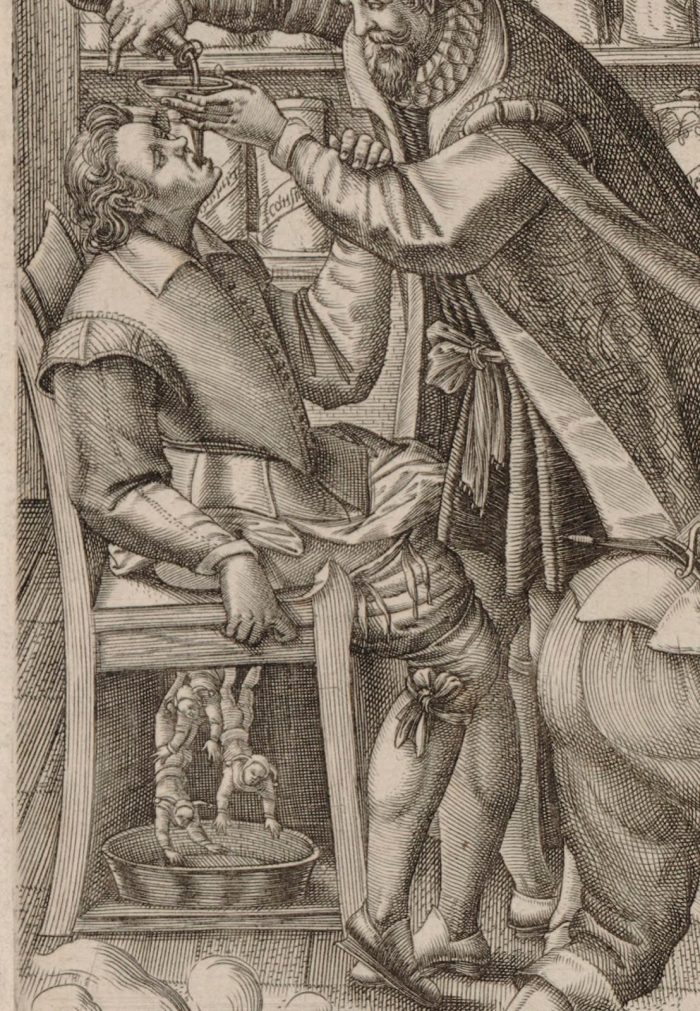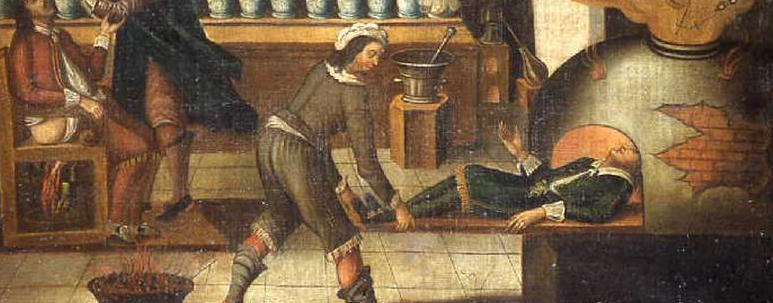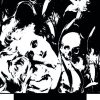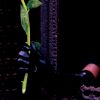The image above is a detail from a remarkable 1620 engraving I first came across this past summer. It shows a man sliding another figure into what looks like an old-fashioned oven – but instead of smoke, images of the man’s thoughts billow out of the oven’s top. The “baker” is in fact an apothecary, the “oven” is a distillation apparatus, and the man whose thoughts are boiling out of his head is someone being treated (metaphorically) for madness.
The full image is even stranger. Two well-dressed figures stand before a wall of shelves stocked with drug jarsbearing labels like Modestie, Raison, and Memoire. One is pouring a potion marked Sagesse (wisdom) into the opened mouth of a seated figure who grips the pourer’s arm uneasily. Below, court jesters wearing fool’s caps tumble into a bedpan.
To the right of these two— leaning in front of a distillation apparatus, a mortar and pestle, and a lengthy medical receipt pinned to the shelf—is an apothecary pushing a man on a long board into a distillation furnace. Above, the fantasies that had filled this man’s head emerge as the rarified quintessences of distillation: horses, backgammon boards, armor, pantaloons, women, swords, theater masks, flowers, hunting dogs, and, unaccountably, a monkey brandishing a walking stick.
“Le Médecin guérissant Phantasie,” Mattheus Greuter, 1620 (Bibliothèque nationale de France).
I think that it’s one of the most memorable and mysterious depictions of early modern science and medicine I’ve ever seen, and I thought I’d try to figure out a bit more about it here.
The most obvious place to start is with the French caption which accompanies the image. Here’s the original French:
Aprochez vous qu’avez la teste pleine
de phantasie, qui vous met en grande peine
assurez vous de ce Maistre sçavant,
quil voz humeurs seicherat tellemant,
dedans ce four, qu’aurez en peu de temps,
grand allegeance de beaucoup de torments,
aussi serez purge per ses brevages
qu’incontinant deviendrez du tout sages.

And here’s my attempt to render it in something resembling the couplet rhyme scheme of the original:
You, come here! Your head is filled
With fantasies, that make you ill
Of this learned Master, be assured
That he will have your humours cured
In no time at all, within this furnace—
Great allegiance of many torments—
So too, he’ll purge with healing potions
That can make the foolish cogent.
Even after the cursory research that I did when I first encountered the image, it became clear that this was a pretty popular motif. The basic imagery of a cloud of “phantasies” being distilled from a fool’s head by a physician-alchemist appears in at least seven variants that I’ve been able to find: the French-language version shown above, apparently created by a printer named Mattheus Greuter in 1620; a German-language original from 1596 along with several later copies; a much-altered English versions; and, fascinatingly, a full-color French painting that was seemingly based on the engraving rather than the other way around.
The earliest iteration of the image would seem to be from a book of emblems created by the Belgian engraver and printer Theodor de Bry (1528-1598) which was published two years before his death. This included a picture of a “Narrendoktor” (Fool Doctor) distilling the madness or folly out of a man’s head using an alchemical still, while his associate opens a spigot in a man’s stomach to purge him of his foolish humors. Interestingly, this version shows a closer attention to the actual technology of distillation, as it also shows a solid distillate falling to the ground in the form of mice. The Latin caption can be translated to something like “My art can be all knowledge–except wisdom.”
Read The Rest Of This Interesting Feature
HERE! Thank You
Res Obscura for sharing this with us!














